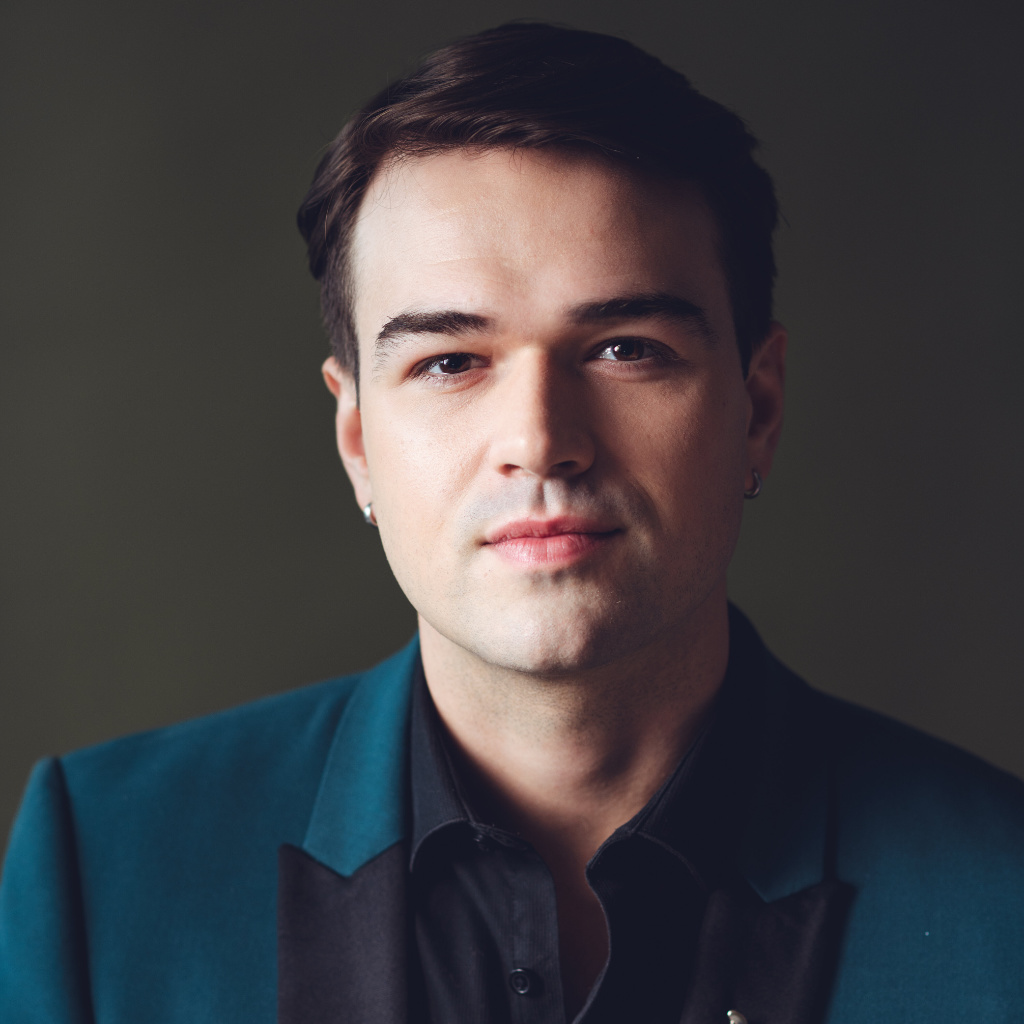The Artists
Cosette Justo Valdés
Chelsea Mahan Jeanson
Emma Gillingham
Ian Sabourin
Spencer McKnight
Jayden Burrows
Additional Artists
SSO Chorus
Duff Warkentin, choral conductor
Kerry Agnew, rehearsal pianist
Soprano 1
Kathleen Brannen
Susan Ens-Funk
Lynn Ewing
Jami Gubbe
Theresa Loewen
Celeste Woloschuk
Soprano 2
Lindy Antonini
Tanya Bergen
Catherine Berntson
Michelle McKinnell
Laura Marie Piotrowicz
Vita Skvairson
Alto
Aubree Bangsund
Gary Day
Marissa Evans
Lynette Janzen
Kathryn Janzen
Catherine Klopoushak
Mary Loewen
Heather MacNab
Elaine Thaller
Tenor
Alfonso Bolarin Guellin
Bob Dick
Peter Hooge
Tony Kim
Derrick Lee
David Woloschuk
Bass
Brady Anderson
Patrick Brannen
Blake Cumming
James Hawn
Jonathan Moore-Wright
Matthew Praksas
Michael Siebert
Jeremy Wiebe
Dixit
Baroque Resonance
Cosette Justo Valdés, conductor
Chelsea Mahan Jeanson, soprano
Emma Gillingham, soprano
Ian Sabourin, countertenor
Spencer McKnight, tenor
Jayden Burrows, bass
SSO Chorus, Duff Warkentin
Saskatoon Symphony Orchestra
“Arrival of the Queen of Sheba” from Solomon
George Frideric Handel
Orchestral Suite No. 1 in C Major, BWV 1066
Ouverture
Courante
Gavotte I
Gavotte II
Forlane
Menuett I
Menuett II
Bourrée I
Bourrée II
Passepied I
Passepied II
Johann Sebastian Bach
Dixit Dominus, HWV 232
I. Dixit Dominus
II. Virgam virtutis
III. Tecum principium
IV. Juravit Dominus
V. Tu es sacerdos
VI. Dominus a dextris tuis
VII. De torrente in via bibet
VIII. Gloria Patri
George Frideric Handel
Dixit Dominus, HWV 232
Dixit Dominus is a psalm setting by George Frideric Handel. Catalogued as HWV 232, it uses the Latin text of Psalm 110 (Vulgate 109), starting with the words “Dixit Dominus,” which means “The Lord Said.”
In 1795, the 20 years old George Frideric Handel had just begun to establish himself as an opera composer in Hamburg after he presented his first two operas that year. However, the pope briefly banned operatic performances in 1707, meaning he could no longer publicly perform most of his composition. Hence, Handel took on writing religious music, went onto a trip to Italy, and completed Dixit Dominus in April 1707. This became a strategy that would serve him well in later years, composing the Messiah.
Dixit Dominus was written in baroque style, and it is scored for five vocal soloists (SSATB), five-part chorus, strings and continuo. It is thought that the work was first performed on 16 July 1707 in the Church of Santa Maria in Montesanto, under the patronage of the Cardinal Carlo Colonna. The psalm text seems well-suited to impress a patron from a powerful Roman family like the Colonnas, as it speaks of a ruler’s triumph over his enemies.
Dixit Dominus Translations
Latin Text
1 Dixit Dominus Domino meo: sede a dextris meis, donec ponam inimicos tuos
scabellum pedum tuorum.
2 Virgam virtutis tuae emittet Dominus ex
Sion: dominare in medio
inimicorum tuorum.
3 Tecum principium in die virtutis tuae in
splendoribus sanctorum:
ex utero, ante luciferum, genui te.
4 Juravit Dominus et non poenitebit eum:
(5) tu es sacerdos in aeternum secundum
ordinem Melchisedech.
5 (6) Dominus a dextris tuis: confregit
in die irae suae reges.
6 Judicabit in nationibus, implebit ruinas:
conquassabit capita in terra multorum.
7 De torrente in via bibet: propterea
exaltabit caput.
Church of England 1662 Book of Common Prayer
1The Lord said unto my Lord: Sit thou on my
right hand, until I make thine enemies
thy footstool.
2 The Lord shall send the rod of thy power out
of Sion: be thou ruler, even in the midst among
thine enemies.
3 In the day of thy power shall the people offer
thee free-will offerings with an holy worship:
the dew of thy birth is of the womb of the morning.
4 The Lord swore, and will not repent:
(5) Thou art a priest for ever after the
order of Melchisedech.
5 (6) The Lord upon thy right hand: shall wound
even kings in the day of his wrath.
6 He shall judge among the heathen;
He shall fill the places with the dead bodies:
and smite in sunder the heads over diverse countries.
7 He shall drink of the brook in the way:
therefore shall he lift up his head.
George Frideric Handel
George Frideric Handel (1685-1759) is a prominent figure from the Baroque era. He is well-known for his operas, oratorios, and instrumental works, heavily influenced by Italian opera and English choral traditions. Some of his most famous compositions are Dixit Dominus (1707), Water Music (1717), Music for the Royal Fireworks (1749), and Messiah (1741).
Born in Halle, Germany, Handel did not grow up in a musical family, but his gifts were so obvious that his father allowed him to take lessons. Handel became an accomplished organist, harpsichordist, and studied violin and oboe, and learnt composition through copying scores of other composers (which was honored at the time). At the age of 18, rather than become a church cantor, Handel went to Hamburg, the center of German opera, and composed his first opera Amira.
Despite being known for his imperious nature and quick temper, Handel was also recognized for his humor, generosity, integrity, and piety. During the last seven years of his life, Handel was blind but continued to conduct and revise his works with the assistance of his loyal friend, J.S. Schmidt. By the time of his death in London in 1759, Handel had become a cherished figure in English culture.
J.S. Bach
Born in Eisenach, Germany, Bach spent most of his life in his homeland, working in various capacities as an organist, composer, and music director.
Johann Sebastian Bach (1685-1750) was born into a prolific musical family in Eisenach, Germany. Orphaned at the age of 10, he was raised by his elder brother, Johann Christoph, who taught him to play the organ and klavier, and introduced him the works of prominent composers of the time.
Bach was famous as an organ virtuoso. As a composer, his reputation in his lifetime was restricted to a fairly narrow circle and his music was regarded by many as old-fashioned. His fame wasn’t any close to Telemann, and only very few of his compositions were printed, contracting to his reputation today. For half a century after his death, this position was only slightly improved until in 1801 the Well-Tempered Klavier was issued.
The revival of interest in Bach’s music was led by German composer and pianist Felix Mendelssohn. The 15 years old young composer was given a copy manuscript score of the St Matthew Passion by his grandmother Bella Salomon. Bach’s work wasn’t favoured at the time because of its complexity and the unfamiliarity of its language. Others have attempted to mount a performance of the Passion, but the work required significant effort by a genius with vision to complete it. Mendelssohn put his mind to work and five years later, an abridged version of the work was rehearsed and conducted by him in a performance at the Singakademie on March 11, 1829. For the first time in a century, the beauty of the St. Matthew Passion was revealed to the German public, eliciting a response not unlike that experienced by young Felix on seeing the work’s score for the first time. This historic performance, due in large part to Mendelssohn’s vision (he was only fifteen when he first saw the score of the Passion, and twenty when his efforts to perform the work were realized), resulted in a full-scale revival and reevaluation of Bach’s works throughout Germany and beyond, and a universal recognition of their genius and significance.





